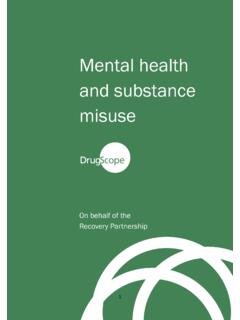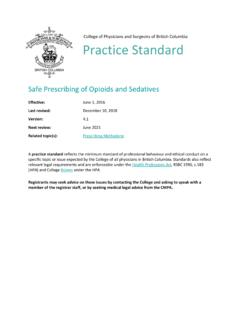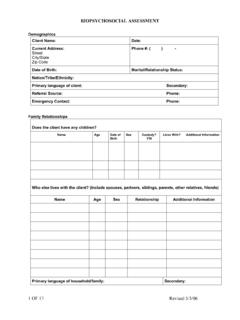Transcription of Positive Practice Guide for working with users of drugs ...
1 1 IAPT Positive Practice Guide for working with people who use drugs and alcohol Introduction 1. This Guide seeks to assist IAPT teams and substance misuse services to work confidently and inclusively with those who have drink or drug problems and common mental health problems. It explains how simple assessment techniques and protocols can identify potential IAPT clients with drink or drug problems. It outlines criteria for deciding whether people with different kinds of drug and alcohol use are suitable for IAPT services. And it summarises how IAPT and substance misuse services can work together more closely to improve outcomes for clients.
2 Background 2. A new national drug (and alcohol dependence) strategy was published in December 2010 (HMG, 2010), and a mental health strategy a few months later (HMG, 2011). Both strategies acknowledge the association between mental health problems and drug and alcohol problems. Successful outcomes for both problems need early intervention and effective joint working between drug and alcohol treatment and mental health services in integrated, recovery-oriented local systems. 3. People with a history of drug and alcohol problems, and receiving treatment, do not necessarily pose any special challenges for IAPT services but there are often substantial clinical gains to be made in working with them.
3 Substance misuse clients with mental health problems should have access to NICE-recommended psychological interventions, including CBT for depression and anxiety and there is no evidence that substance misuse per se makes the usual psychological therapies ineffective (NICE, 2007). 4. Illicit drug use, misuse of and dependence on over-the-counter and prescribed medicines, and alcohol use are common in Great Britain. It is estimated that million people have mild, moderate or severe alcohol dependence (McManus et al., 2009). Thirty six per cent of adults report lifetime use of illegal drugs , with eight per cent using in the last year and five per cent in the last month (Hoare and Moon, 2010).
4 A significant number of IAPT clients are therefore likely to be using illicit or prescription drugs and/or drinking at hazardous or harmful levels that may be contributing to their mental health problems. 5. Between 70 and 80 per cent of clients in drug and alcohol services have common mental health problems, largely anxiety, depression and trauma (Weaver, 2003). The same study also found high levels of drug use and hazardous and harmful drinking in the populations using mental health services. The study concluded that substance misuse services should work more collaboratively with local psychotherapy services and GPs to improve management of co-morbid patients who do not meet the criteria for access to community mental health services.
5 IAPT Positive Practice Guide for working with people who use drugs and alcohol January 2012 2 6. IAPT services do not provide complex interventions to treat substance use problems but drug and alcohol use should not be an automatic exclusion criterion for accessing psychological therapy. Most drug and alcohol users do not need specialist or clinical interventions to change their substance use behaviour and, of those that do, many will respond to brief interventions delivered in primary care. Only a small proportion of drug and alcohol users will require specialist treatment services and, in some circumstances, referral to drug and alcohol services will be appropriate.
6 7. The expertise available within drug and alcohol treatment services to provide evidence-based psychological interventions will often be limited. IAPT services may provide one of the only local resources for clients of drug and alcohol services to access psychological therapy for common mental health problems. It is important, therefore, for IAPT and drug and alcohol treatment services to work together to address the needs of people with co-occurring problems. Information-sharing and communication between IAPT and drug and alcohol services at the local level can be a significant first step.
7 Understanding the needs of users of drugs and alcohol 8. While people with serious drug and alcohol problems come from all walks of life and different backgrounds, they are often affected by multiple disadvantages, either as a consequence or as a cause of their dependent drug use (Carpentier, 2002). 9. Socio-economic factors related to drug use include low educational levels, early school leaving and drop-out; unemployment, low salaries and difficult jobs; low income and debt; insecurity of accommodation and homelessness; mortality and drug-related diseases; poor access to care; and social stigma.
8 Relative differences in the social conditions of drug users are found by substance used; the worst conditions being found among those dependent on opiates, particularly heroin (EMCDDA, 2003). While these social factors may complicate aspects of psychological work, they also highlight the extensive need within the population and the importance of working inclusively with this group. Identification and engagement by IAPT of substance misusers 10. The NICE guideline for alcohol-use disorders recommends that all NHS-funded services should be competent to identify harmful drinking (NICE, 2011).
9 Routine assessment of current use of drugs and alcohol is therefore recommended for all IAPT clients. 11. The Alcohol Use disorders Identification Test (AUDIT) is a useful screening tool for alcohol problems. The NICE guideline for alcohol suggests that for clients who typically drink over 15 units of alcohol per day, and/or who score 20 or more on the AUDIT, should be assessed for community-based assisted withdrawal. This may be through the General Practitioner or, if there are safety concerns, may require assessment and management in a specialist alcohol service. IAPT Positive Practice Guide for working with people who use drugs and alcohol January 2012 3 12.
10 In addition to alcohol, questions should also capture the most prevalent illicit drug use; cannabis, cocaine, ecstasy (MDMA) amphetamine, ketamine and heroin as well as prescribed drug use: benzodiazepines and opioid based pain relief. Local drug partnerships may have agreed simple screening tools that can be used by non-drug specialist services, including IAPT. 13. It is important to appreciate clients potential sensitivities to direct questions about their drug and alcohol use. Their experience may have led them to believe they will be criticised about their use or denied access to a service and they may have concerns about confidentiality.




